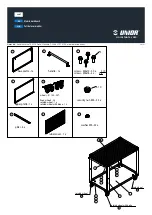
HT67F86A Internal RTC Application Guidelines
AN0448E V1.00
2/7
January 16, 2017
The clock frequency block diagram is shown as below.
HXT
Prescaler
f
H
LXT
High Speed
Oscillator
Low Speed
Oscillator
f
H
/2
f
H
/16
f
H
/64
f
H
/8
f
H
/4
f
H
/32
CKS2~CKS0
f
SYS
f
SUB
f
SUB
HXTEN
f
LXT
HIRC
HIRCEN
f
H
FHS
IDLE2
SLEEP
LXT Oscillator
The LXT oscillation circuit consists of an external 32768Hz crystal and resistor as well as
capacitor components. The crystal is connected between pins XT1 and XT2. The
frequency accuracy adjustment is implemented by the R
P
resistor together with the C1
and C2 capacitors. Users should refer to the oscillator specification for the resistance and
capacitance configurations. After power on the LXTEN bit will be in a high state which
enable the LXT oscillator. By examining if the LXTF bit has been set high, it can be
determined if the LXT oscillator is powered up and ready for use. The LXT oscillator
circuit is shown as below.
Note: 1. R
P
, C1 and C2 are required .
2. Although not shown pins have a parasitic capacitance of around 7pF.
To internal
circuits
Internal
Oscillator
Circuit
C1
C2
XT1
XT2
R
P
32.768kHz
Internal RC
Oscillator
External LXT Oscillator
Time Base Control Register
The HT67F86A provides a Real Time Clock function. A time counting function can be
implemented by configuring the Time Base 0 or Time Base 1 interrupt control bits, TB0E
or TB1E, together with the data memory. The time base function clock source, f
PSC,
comes
from the f
LXT
. The Time Base frequency division ratio is selected by configuring the
registers to choose a value within the range of f
PSC
/2
8
~ f
PSC
/2
15
. Refer to the datasheet for
the related registers and the TB0E and TB1E interrupt addresses.

























